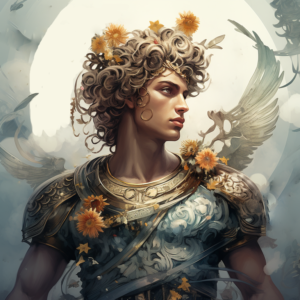Jupiter is the Roman god of the Sky. He was also the chief of the pantheon of the gods, as well as a protector of the Roman state. His name is derived from the Greek root word diu, meaning “bright.” Jupiter’s equivalent in Greek mythology is Zeus. Like Zeus, Jupiter was believed to reside at Mount Olympus in Greece.
Origins
Jupiter’s origins are a story of deliverance. According to Roman mythology, his father, Saturn, devoured each of his children as soon as they were born so that they would not grow up to take vengeance upon him and his place as ruler of the gods.
Jupiter’s mother, Ops, was saddened by the loss of her children. She hid Jupiter in a cave and swaddled a stone in infant clothing, which she gave to Saturn. He consumed the stone, and Jupiter was safe. Eventually, Jupiter freed his siblings, still alive within their father’s belly. Although chief deity, he shared his power with his brothers and sisters as they ruled over lesser deities and humankind.
Appearance
In modern times, Jupiter is commonly portrayed as being strong, muscular and wearing a toga. He is also often seen holding a lightning bolt.
In the Renaissance to Baroque eras, his appearance could change from painting to painting. This often had to do with the circumstance of the story that was being painted about. For example, in a painting of Jupiter and Io by Antonio da Correggio that was completed around 1530, Jupiter is disguised as a cloud that is grabbing hold of Io. In another painting by François Boucher in 1744, he is disguised as Diana in order to seduce Callisto.
There were many commonalities in portrayals of him when he was not in disguise. Many artists portrayed him as looking down from clouds in the sky and the heavens. He was often older, with long, gray or brown, curly hair and many times sported a thick beard. He was usually shown exuding or commanding substantial power.
Numerous sculptures have been created of Jupiter as well. These sculptures were created in eras ranging from ancient Rome to the Renaissance and beyond. Many of these sculptures depicted the god in a way similar to many of the paintings. In one famous ancient Roman sculpture, he can be seen seated on a throne and holding a large staff. He has long, curly hair and a large eagle is standing next to him with its wings outstretched.
Family
As noted above, Jupiter’s parents were Saturn and Ops. He had five siblings: Juno, Ceres, Neptune, Vesta and Pluto.
Jupiter had a number of children with various wives. In mythology, he was often engaging in sexual relationships with different mortals and immortals, enraging his wife Juno in the process.
There are some prominent relationships and children that can be noted. Jupiter and Juno gave birth to Minerva, Juventia, Mars and Vulcan. Jupiter and Ceres gave birth to Prosperpina. And finally, Jupiter and the mortal Semele had Bacchus.
Symbols
The most well-known symbol associated with Jupiter is the lightning bolt. Another common animal that is connected to him is the eagle, a bird that is connected to many sky gods. The oak tree is another symbol that has been linked to Jupiter.
Myths
Jupiter plays a role in many ancient Roman myths. For example, humans or lesser gods often come to Jupiter for justice or assistance. Phaethon is said to have lost control of his father’s chariot pulled by four horses, which carried the sun across the sky. The intense heat of the sun was scorching the earth, causing fires and creating vast deserts. Jupiter answered the prayers of the mortals by destroying the chariot with his lightning bolt and thunder. In another myth, similar to the biblical account of the Noachian flood, Jupiter assumes human form to see if the rumors of man’s wickedness are true. He is appalled by their actions, and punishes them using a great flood.
Worship
Jupiter was worshiped on hilltops throughout Italy, the seat of the Roman Empire. Even before Rome came to power as an empire, Jupiter Latiaris was worshiped on the hills south of Rome, then part of a coalition of twelve cities. Oaths were sworn outdoors on the hills, under the oversight of Jupiter. Rome itself was situated on the Capitoline Hill, home to the temple shared as a triad, or trinity, by Jupiter, Minerva, and Juno. There, worship involved a sacred oak tree and the lapides silices, flint stones used ceremonially by the priests who both declared war and signed treaties. These priests also officiated marriage ceremonies.
Like his Greek counterpart, Zeus, Jupiter was associated with the lightning bolt. Jupiter Elicius was often solicited by worshipers to bring rains in seasons of drought, and areas struck by lightning were hemmed in with a circular wall, considered the claimed property of Jupiter Fulgar and not to be profaned. These areas were purified with the sacrifice of an onion, a human hair, and fish.
Festivals
On September 13, a festival to Jupiter Optimus Maximus, meaning “the best and greatest of all the Jupiters,” was held in Rome. This corresponded to the date when certain Roman leaders had ascended to office and taken a special oath. A white ox, said to be Jupiter’s favorite gift, was sacrificed in thanks of another year of protection. Then, feasting ensued. This festival also corresponded to the time of the Roman games.
Before going to war, priests danced with twelve shields, one of which was said to have fallen from heaven as a sign from Jupiter. The other eleven were made by craftsmen, so that if one was stolen, it would not likely by the original. When the Roman armies returned triumphantly home from battle, great processions wound through the city to the temple of Jupiter. The triumphant general leading the procession was robed as the god himself, riding in a chariot and driving prisoners of war before him.
Today
Centuries after Jupiter had ceased to be worshiped as part of the Roman religion, his influence on popular culture was still evident in the realms of art and literature. The literary term “sub Iove” was used to mean “under the open sky.” His image is common in paintings throughout the Middle Ages and the Renaissance.
Facts about Jupiter
- Role in Mythology: Chief of the gods, sky god, protector of Rome, god of oaths and treaties
- Alternate Names: Iovis, Iove, Jove, Iuppiter, Diespiter, Calestis, Lucetius, Totans, Fulgurator, Indiges
- Family Relationships: Son of Saturn, brother of Neptune and Juno, husband of Juno
- Symbols: Lightning bolt and eagle





